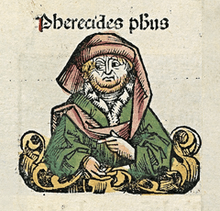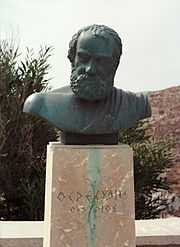Pherecydes of Syros
| Pherecydes of Syros | |
|---|---|
 Pherecydes, ancient Greek philosopher. | |
| Born | c. 580 BC |
| Died | c. 520 BC |
| Era | Pre-Socratic philosophy |
| Region | Western Philosophy |
| School | Pre-Socratic |
Main interests | Cosmogony, mythology, theology |
Notable ideas | Metempsychosis |
|
Influences
| |
|
Influenced
| |
Pherecydes of Syros (/fəˈrɛsɨˌdiːz/; Φερεκύδης; fl. 6th century BC) was a Greek thinker from the island of Syros. Pherecydes authored a cosmogony, derived from three divine principles, Zas (Zeus),[1] Cthonie (Earth)[2] and Chronos (Time), known as the "Pentemychos" (Πεντέμυχος, "of the five recesses", sometimes the alternative title "Heptamychos", "seven recesses" is given). It formed a bridge between the mythological thought of Hesiod and pre-Socratic philosophy. His work is lost, but it survived into the Hellenistic period and we are informed on part of its content indirectly. Pherecydes was said to have been the first writer to communicate philosophical musings in prose.
Life
According to tradition Pherecydes was a native of the island of Syros and flourished in the 59th Olympiad (544–541 BC).[3][4] It was said that he was a son of one Babys. Schibli (1990) dates his birth in the 49th olympiad (584–581).
Anecdotes of "unknown reliability"[5] place Pherecydes on the island of Samos, and in the city of Ephesus, where he is supposed to have been buried, although another tradition claims he was buried on Delos.[6]
Aristotle wrote in his Metaphysics[7] of Pherecydes being in part a mythological writer and Plutarch, in his Parallel Lives,[8] instead wrote of him being a theologian. He was considered to have had the greater significance in teaching on the subject of metempsychosis.[9]
His writings were extant in the Hellenistic period, although only fragments have survived to the present day. His works were written in prose rather than verse and he has been said to have been the first to have communicated or conveyed philosophical musings in this form.[10]
Cosmogony
Some sources say that Pherecydes' book was entitled "Pentemychos" (Πεντέμυχος Pentemuchos) translated as five (πέντε) "recesses" (μυχός muchos, "nook, cranny, recess", also "sanctuary" as in "small domestic altar in a corner").[11] in some sources said to have been titled "Heptamychos" ("seven (ἑπτά) recesses"). There seems to be no complete agreement among scholars on which sources to trust regarding the title of Pherecydes' book, the standard survey reference on the Presocratic philosophers by Kirk, Raven and Schofield, opts for "Heptamychos".[12] The author of the only modern scholarly book devoted entirely to Pherecydes, Hermann S. Schibli, argues that "Pentemychos" was the true title.[13] In this work, Pherecydes taught his philosophy through the medium of mythic representations. Although it is lost, the fragments that survive are enough to reconstruct a basic outline.
In the older cosmogony of Hesiod (8th–7th century BC) the initial state of the universe is Chaos, a dark void considered as a divine primordial condition and the creation is ex nihilo (out of nothing). Pherecydes probably interpreted chaos as water and he does not place it at the very beginning. In his cosmogony there are three divine principles, Zas (Ζάς, Zeus), Cthonie (Χθονίη, Earth) and Chronos (Χρόνος, Time) who always existed.
The semen (seeds) of Chronos which can probably be considered as a watery chaos was placed in the recesses and composed numerous other offsprings of gods.[14] This is described in a fragment preserved in Damascius' On First Principles.
A close relationship is thought to exist between these recesses and Chthonie. Hesiod described Tartaros as being "in a recess (muchos) of broad-wayed earth".[15] Hermann S. Schibli thinks the five muchos were actually harboured within Chthonie, or at least were so initially when Chronos disposed his seed in the five "nooks".[16]
Alongside Chthonie and Chronos, Pherecydes held a power called Zas. Zas (Zeus), comparable with the Orphic Eros in function, and as such a personification of masculine (sexual) creativity. Proclus said that "Pherecydes used to say that Zeus changed into Eros when about to create, for the reason that, having created the world from opposites, he led it into agreement and peace and sowed sameness in all things, and unity that interpenetrates the universe".[17]
The act of creation itself (perhaps it is more accurate to say that Chronos creates and that Zas orders and distributes) is described mytho-poetically as Zas making a cloth on which he decorates earth and sea, and which he then presents as a wedding gift to Chthonie, and wraps around her. Yet, in another fragment it is not Chthonie, but "a winged oak" that he wraps the cloth around.[18] The "winged oak" in this cosmology has no precedent in Greek tradition.[19] The stories are different but not mutually exclusive, because much is lacking in the fragments, but it seems clear that creation is hindered by chaotic forces.


Before the world is ordered a cosmic battle takes place, with Kronos (ordered time) as the head of one side and Ophioneus as the leader of the other.[20] The same story is elsewhere enacted with Zeus and Typhon/Typhoeus as leading characters, and it also has close parallels in many myths from cultures other than the Greek (Marduk vs. Tiamat, etc.). Ophioneus and its brood are often depicted as ruling the birthing cosmos for some time, before falling from power. The chaotic forces are eternal and cannot be destroyed; instead they are thrown out from the ordered world and locked away in Tartaros in a kind of "appointment of the spheres", in which the victor (Zeus-Kronos) takes possession of the sky and of space and time.[21] The locks to Tartaros are fashioned in iron by Zeus, and might hence have been associated with his element of aither, and in bronze by Poseidon, which might indicate a link to water (which was often conceived of as the "first matter"). Judging from some ancient fragments Ophioneus is thrown into Okeanos, not into Tartaros.
Exactly what entities or forces that were locked away in Pherecydes’ story cannot be known for sure. There may have been five principal figures. Ophioneus and Typhon are one and the same, and Eurynome fought on the side of Ophioneus against Kronos.[22] Chthonie is a principal "thing" of the underworld, but whether she is to be counted as one of the five or the five "sum-total" is an open question. Apart from these it is known that Ophioneus-Typhon mated with Echidna, and that Echidna herself was somehow mysteriously "produced" by Callirhoe. If Pherecydes counted five principal entities in association the pentemychos doctrine, then Ophioneus, Eurynome, Echidna, Calirrhoe and Chthonie are the main contenders.
Kronos (or Zeus in the more popularly known version) orders the offspring out from the cosmos to Tartaros. There they are kept behind locked gates, fashioned in iron (associated with Zeus and his element of sky/space) and bronze (by Poseidon—the water force). We are told about chaotic beings put into the pentemychos, and we are told that the Darkness has an offspring that is cast into the recesses of Tartaros. No surviving fragment makes the connection, but it is possible that the prison-house in Tartaros and the pentemychos are ways of referring to the essentially same thing. According to Celsus, Pherecydes said that: "Below that portion is the portion of Tartaros; the daughters of Boreas [the north wind], the Harpies and Thuella [Storm], guard it; there Zeus banished any of the gods whenever one behaves with insolence."[23] Thus the identity between Zeus' prison-house and the pentemychos seems likely.
Influence
Pherecydes' "Pentemychos" was thought to have contained a mystical esoteric teaching, treated allegorically. One ancient commentator said that:
Also, Pherecydes, the man of Syros, talks of recesses and pits and caves and doors and gates, and through these speaks in riddles of becomings and deceases of souls.[24]
A comparatively large number of sources say Pherecydes was the first to teach the eternality and transmigration (metempsychosis) of human souls.[25] Both Cicero and Augustine thought of him having given the first teaching of the "immortality of the soul".[26] It is not surprising that some considered Pherecydes to have been the teacher of Pythagoras.[27] That he was the first to teach such a thing is doubtful, but that he was among the first and that he did profess this teaching is certain. Hermann S. Schibli concludes that Pherecydes "included in his book ["Pentemychos"] at least a rudimentary treatment of the immortality of the soul, its wanderings in the underworld, and the reasons for the soul’s incarnations".[28]
Pherecydes was occasionally counted among the Seven Sages of Greece.[29] A sun-dial (heliotropion), supposedly made by Pherecydes, was said by Diogenes Laërtius to be "preserved on the island of Syros."[30]
References
- ↑ "Doric and Attic-Ionic forms with α (of doubtful origin), nom. Ζάν [...] nom. Ζάς Pherecyd.Syr.1, 2 (Ζής ap.Hdn.Gr. l.c.[2.911]), "Ζάς Ζαντός" Choerob. in Theod.1.116; Δάν (q. v.); Τάν Head Hist.Num.2469 (Crete)" Ζεύς – Henry George Liddell, Robert Scott, A Greek-English Lexicon
- ↑ "Ionic ἡ χθονίη, an earlier name of Γῆ [Pherecyd.Syr.1, cf. Dam.Pr.124bis]" χθόνιος – Henry George Liddell, Robert Scott, A Greek-English Lexicon
- ↑ C. H. Kahn, (Harvey Yunis ed.), Written texts and the rise of literate culture in ancient Greece, 262 pages ISBN 0-521-80930-4 Cambridge University Press, 2003 Retrieved 2012-02-08
- ↑ Herbert Granger, (2007), The Theologian Pherecydes of Syros and the Early Days of Natural Philosophy, pp. 135–163 Harvard Studies in Classical Philology. Vol. 103.
- ↑ Mark Henderson Munn, The Mother of the Gods, Athens, and the tyranny of Asia: a study of sovereignty in ancient religion, 452 pages ISBN 0-520-24349-8 p48 University of California Press, 1 June 2006 Retrieved 2012-02-08
- ↑ Diogenes Laertius, i. 116-121; Diodorus Siculus, 10.4.3; Suda, Pherekudes Babuos Syrios
- ↑ Aristotle, Metaphysics, 1091b8
- ↑ Plutarch, Sulla 36
- ↑ Cicero, Tusculan Disputations, i. 16
- ↑ William Smith, (1870), Dictionary of Greek and Roman Biography and Mythology, Boston, Little archive Retrieved 2012-02-08 and also earlier
- ↑ πεντέ-μυχος – Henry George Liddell, Robert Scott, A Greek-English Lexicon
- ↑ G.Kirk, J.Raven & M. Schofield (2003). The Presocratic Philosophers. Cambridge University Press. p. 51,
- ↑ H.S.Schibli (1990). Pherekydes of Syros. Clarendon Press Oxford. p. 48,
- ↑ Kirk et al., pp. 56–60
- ↑ Kirk et al., p. 34
- ↑ H.S.Schibli, p. 22
- ↑ Kirk et al., p. 62
- ↑ Kirk et al., p. 63
- ↑ Martin Litchfield West Indo-European poetry and myth, 525 pages ISBN 0-19-928075-4 page 347 Oxford University Press, 12 July 2007]
- ↑ Kirk et al., p. 66
- ↑ Kirk et al., pp. 66-67,
- ↑ Kirk et al., p. 66"
- ↑ Schibli, p. 22
- ↑ Kirk et al., p. 59
- ↑ Schibli, p. 104
- ↑ 9th Edition of Encyclopedia Britannica, Volume 18: Pherecydes Of Syros Retrieved 2012-02-08
- ↑
 Diogenes Laërtius, Book 1, 13, 118-9.
Diogenes Laërtius, Book 1, 13, 118-9.  Book 8, 2, 40.
Book 8, 2, 40. - ↑ Schibli, p. 108
- ↑
 Diogenes Laërtius, Book 1, 122.
Diogenes Laërtius, Book 1, 122.
See also Parada, Carlos; Förlag, Maicar (2007). "The Seven Sages of Greece". Greek Mythology Link. Carlos Parada and Maicar Förlag. Retrieved 13 November 2014. - ↑
 Diogenes Laërtius, Book 1, 119.
Diogenes Laërtius, Book 1, 119.
Further reading
- Hermann S. Schibli, (1990), Pherekydes of Syros. Oxford University Press. ISBN 0-19-814383-4
External links
 Diogenes Laërtius, Life of Pherecydes, translated by Robert Drew Hicks (1925).
Diogenes Laërtius, Life of Pherecydes, translated by Robert Drew Hicks (1925).- Pherecydes of Syros by Giannis Stamatellos
- Fragments and Life of Pherecydes at demonax.info